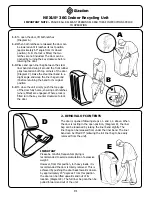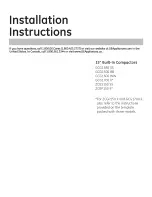
When Constant RPM Management is “ON”
Fluctuations in the engine speed due to load
fluctuations are reduced and the travel speed and PTO
speed are kept nearly constant, allowing stable work.
When
Constant RPM Management
is
“ON”
, the switch's
indicator lights up.
When Constant RPM Management is “OFF”
As in a conventional engine, the engine speed
increases or decreases according to changes in the
load. The operator judges the size of the load from the
engine speed and engine sound, and can adjust the
travel speed or plowing depth to prevent overload on
the tractor.
(1) Constant RPM Management switch with indicator
NOTE :
• In a mechanically-controlled engine, the engine
speed changes according to increases and
decreases in the load.
For example, when working in a hilly area, the
load increases and engine speed drops while
ascending a slope, and conversely the engine
speed increase and the load drops when
descending. These changes in engine speed
affect the travel speed and PTO-driven
implements. In order to minimize these effects,
the operator must make fine adjustments to the
travel speed and hand throttle lever.
When the Constant RPM Management switch in
this tractor with its electronically controlled
engine is turned “ON”, the engine speed will be
kept nearly constant in response to a certain
level of load fluctuations. This improves the
accuracy of work without the need for
troublesome manipulation of the travel speed
and hand throttle lever.
• There is a limit to the range within which a
constant speed can be maintained. If a load
exceeding the engine performance is applied,
the engine speed will drop.
• The purpose of Constant RPM Management is
not to increase the engine power.
PARKING THE TRACTOR
WARNING
To avoid personal injury or death:
Before dismounting tractor
• Always set parking brake and lower all
implements to the ground.
Leaving the transmission in gear with the
engine stopped will not prevent the tractor from
accidental rolling.
• Stop the engine and remove the key.
1. Before getting off the tractor, disengage the PTO,
lower all implements, place all control levers in their
neutral positions, pull the parking brake lever to
parking position, stop the engine and remove the
key.
2. If it is necessary to park on an incline, be sure to
chock the wheels to prevent accidental rolling of the
tractor.
(1) Parking brake lever
(2) Release button
(A) “PARKING POSITION”
(B) “TRANSPORT POSITION”
OPERATING TECHNIQUES
1. Differential lock
WARNING
To avoid personal injury or death due to loss of
steering control:
• Do not operate the tractor at high speed with
differential lock engaged.
• Do not attempt to turn with the differential lock
engaged.
• Be sure to release the differential lock before
making a turn in field conditions.
If one of the rear wheels should slip, step on the
differential lock pedal. Both wheels will turn together,
then reduce slippage.
Differential lock is maintained only while the pedal is
depressed.
OPERATING THE TRACTOR
PARKING THE TRACTOR
70
M4N-071, M5N-091, M5N-111
Summary of Contents for M4N-071
Page 5: ......
Page 6: ......
Page 21: ...SAFETY LABELS SAFE OPERATION M4N 071 M5N 091 M5N 111 15...
Page 22: ...SAFE OPERATION 16 M4N 071 M5N 091 M5N 111...
Page 23: ...SAFE OPERATION M4N 071 M5N 091 M5N 111 17...
Page 24: ...SAFE OPERATION 18 M4N 071 M5N 091 M5N 111...
Page 26: ...20 M4N 071 M5N 091 M5N 111...
Page 152: ......
















































